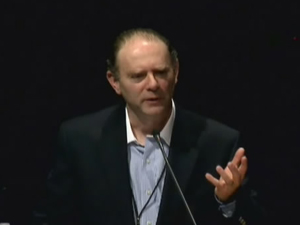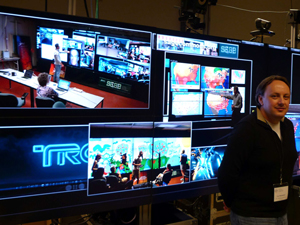CineGrid Takes Digital Cinema Into Next Dimension
San Diego, Calif., Jan. 18, 2011 — For the members of CineGrid, who assembled recently at the University of California, San Diego, for their fifth annual conference, experimenting with “extreme” digital media has increasingly become a finely tuned balance of “3D in support of collaboration, and collaboration in support of 3D.”
“Interest in 3D is being driven by scientific visualization, by consumer electronics and by digital cinema,” remarked Laurin Herr, president of the co
|
CineGrid represents one of the first major research collaborations at the UC San Diego division of the California Institute for Telecommunications and Information Technology (Calit2). Headquartered in California, CineGrid is leveraging next-generation cyberinfrastructure to promote higher-resolution imagery, better sound as well as more secure and efficient distribution of digital media over photonic networks.
As 3D stereoscopic content begins to emerge as an industry focus for television and motion pictures, the stakes are high for the people working behind the scenes to make production and distribution more efficient while creating content that will be attractive for audiences.CineGrid presenter David Wertheimer, the CEO and executive director of the Entertainment Technology Center at the University of Southern California, reported at the conference that 25 percent of consumers are forecasted to buy a 3DTV in the next three years — a percentage that will certainly rise as the price of 3DTVs goes down (from an average of $2,500 today to an expected $600 in 2014).
But that’s presuming the infrastructure for production and distribution can be improved to handle the growth of 3D stereo entertainment. Paul Hearty, vice president of the Technology Standards Office for Sony and a founding member of CineGrid, says that one “simple, brute force way” of looking at 3D cinema streaming is to think of it as requiring twice the number of pixels as standard 2D cinema — and when streamed, it requires twice as much bandwidth. Further, “it’s not only the amount of data that’s challenging," he noted, "it’s keeping both stereo feeds in exact sync."
As 3D collaboration becomes more prevalent in the academic world, it’s vitally important that potentially sensitive scientific data — such as a 3D brain scan being examined by two surgeons working remotely — be rendered with the utmost precision, and transmitted without compression artifacts. Such precision can require as much as two 10Gigabit/second network links.
|
The second main thrust of this year’s CineGrid conference — remote collaboration over high-speed networks — was exemplified in a presentation by Leon Silverman, general manager of Walt Disney Studios’ Digital Studio Operations. Silverman’s presentation, “Opportunities and Challenges of Cinema Post-Production in a Networked World,” described a demonstration of remote collaboration for digital cinema post-production conducted in October 2010 after a nine-month effort involving more than 50 participants from seven CineGrid member organizations who agreed to work together on this project: Disney Studios, NTT Network Innovation Laboratory, Skywalker Sound, Digital Domain, UCSD/Calit2, UIC/EVL, and Pacific Interface.
The CineGrid@Disney demonstration relied on the active cooperation of five of CineGrid’s network members — CENIC, JGN2, GEMnet, PNWGPOP and StarLight.— who provided 1GigE and 10GigE connectivity to the geographically separated participants; in addition, the City of Burbank provided critical last-mile connectivity at 10Gbps from Disney to CENIC, the CineGrid hub in the Los Angeles region.
The CineGrid@Disney demonstration showcased how it is feasible today, using high speed research networks like CENIC, to create a real-time fully interactive networked post-production environment for digital cinema using high quality sound and picture to work between widely distributed facilities on critical creative tasks. The challenge was to bring together, into a single room, several different creative workflows linking multiple remote locations and using very high quality media running over high speed networks for interactive, real-time remote collaboration.
Specific use cases demonstrated included: 4K/60p telepresence virtual conference room; critical viewing of digitally restored archival film elements at 4K and 2K resolutions, streaming from a remote server; Digital Intermediate (DI) color grading; critical viewing of 3D HD stereoscopic visual effects; collaborative audio editing and mixing; and use of a SAGE multi-panel display walls for collaborative review of multimedia marketing materials. While most of these use cases involved point-to-point bilateral collaboration, several required triangular collaboration configurations using multicasting.
|
Calling it an “important moment in telecollaboration,” Silverman said the goal of the demo was to find ways that a “connected” digital studio can better serve filmmakers in an industry increasingly constrained by vast amounts of data, shrinking timeframes for delivery and even something as mundane as freeway traffic.
“Traveling from Burbank to Santa Monica by car takes longer than getting on a plane and traveling to San Francisco,” Silverman noted, adding that more and more film studios are moving their operations abroad to save on time, production costs and (as Herr noted) go “where the talent, or the tax breaks, or the scenery is the best.”
Added Silverman: “Connectivity is going from something that’s nice to have to something we need to have. When we’re linked in exact real-time, these networks literally allow us to shrink time. We want to redefine the experience of collaborating in a virtual meeting room to collaborating in a virtual media room. The ultimate goal is to create an industry platform that can allow the entire industry to connect and work together at once.”
Meanwhile, researchers in academia continue to improve upon platforms they have created for remote collaboration. Richard Weinberg of the University of Southern California (USC) School of Cinematic Arts demonstrated his efforts to “digitize the ocean one drop at a time” in a presentation called “Micro-O-Worlds, where he showcased a selection of live slides and movies of microscopic ocean life that he captured by interfacing a RED camera with a modern optical microscope. Weinberg took advantage of Calit2’s advanced virtual telepresence capabilities to collaborate face-to-face, in real-time, with two USC microbiologists, who gave a play-by-play account of the various micro-organism species on view on the Calit2 auditorium’s 18x32’ screen -- creatures so small they would fit into the letter “e” in the “United States of America” imprint on a dime.
|
“CineGrid has built a global community which helps Calit2 decipher our connected future,” he said. “More and more of Calit2's global projects utilize dedicated 10 gigabit optical lightpaths. Calit2 was born global, born connected at 10 gigabit.”
Research scientist Tom DeFanti, director of visualization at Calit2 and a founding member of CineGrid, says that as CineGrid evolves it has emerged as “the tippy tip of what’s possible.”
“We’ve spent years apologizing for the stability and reliability of the technologies shown at CineGrid conferences in the past, but as these technologies improve, we don’t have to do that anymore. These things we’ve been doing as big experiments all these years have now become the new normal.”
Related Links
Electronic Visualization Laboratory
Media Contacts
Tiffany Fox, (858) 246-0353, tfox@ucsd.edu




.jpg)